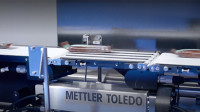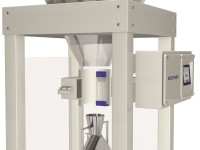Snacking is booming. By 2030, global sales of savoury snacks could hit USD 386.8 billion , and the pressure to deliver a wide variety of high-quality products at speed is growing fast. For manufacturers, this raises a crucial question: How can contamination risks be tackled in fast-moving environments without compromising product quality or operational efficiency?
By Rob Stevens, Market Manager, Mettler-Toledo Produk
Snack and confectionery production lines typically run at high speeds, often exceeding 800 products per minute. At this pace, accurate inspection becomes more difficult, particularly with delicate items or flow-wrapped goods that can be easily damaged or misaligned. As a result, even small issues can lead to high rejection rates, rework or wasted product.
Metal detection and x-ray inspection are key technologies that help manufacturers maintain product safety and integrity. Both offer rapid, precise contaminant detection and can be integrated at various stages along the line.
Metal detectors are widely used to identify ferrous, non-ferrous and stainless steel contaminants. A common approach in vertical snacks applications, such as VFFS (Vertical Form Fill Seal), involves placing a throat metal detector between the weigher and the bagging machine for crisps. This setup allows free-falling product to be inspected before it enters the pack, reducing the risk of contamination post-sealing.
Given the pace and precision required in snack production, these systems are designed for fast throughput while maintaining high detection sensitivity. Whether inspecting loose crisps before bagging or sweets prior to wrapping, they offer a reliable first line of defence against metal contamination.
Where a broader range of contaminants is a concern, such as glass, mineral stones, rubber or dense plastics, x-ray inspection is another viable option. X-ray systems analyse differences in product density to detect unwanted materials inside sealed packs, boxes or trays.
This is especially useful in confectionery, where agglomerates of flavouring or inconsistencies in density can affect both safety and product quality. X-ray systems are most commonly placed at the end of a snacks line to inspect full boxes of items, providing a secondary check beyond single-item inspection. They can also verify product shape, fill levels and detect missing or broken items, helping to maintain consistent output quality.
X-ray systems are especially valuable for lines producing multiple product types. Operators can switch seamlessly between SKUs without lengthy recalibration, thanks to automated settings and software driven changeovers. This not only reduces downtime but also enhances the consistency and reliability of inspection.
To determine the most effective inspection setup, manufacturers should begin with a comprehensive (Hazard Analysis and Critical Control Points) HACCP analysis. This identifies the most likely contamination risks and where (critical control points) CCPs exist along the production line. Both metal detection and x-ray inspection offer solutions that can be implemented across different stages of the process, from incoming raw material to final packaging before shipping, enabling manufacturers to tailor their food safety program to their specific application.
In both snacks and sweets, the risk of plastic contamination is rising. Wear and tear on moulds or packaging components can introduce fragments into the product. These contaminants are often difficult to detect with traditional methods due to their lower density.
X-ray systems, particularly those using dual energy technology, are capable of identifying plastic fragments even when differences in density are minimal. This makes them highly effective for spotting pieces of polypropylene and soft rubber materials that might otherwise reach consumers undetected. This capability is increasingly important as manufacturers deal with growing product variation and complex packaging combinations.
Detecting plastic is not just about meeting internal quality standards, it is also crucial for global export. In markets with stricter safety regulations, undetected plastic contaminants could block entire shipments or damage valuable supplier relationships.
Integrating metal detection and x-ray inspection into the production process helps manufacturers meet Global Food Safety Initiative (GFSI) standards. These contaminant detection systems detect and reject foreign bodies, reducing the risk of recalls and protecting the brand’s reputation. Demonstrating compliance with these rigorous standards enhances credibility in the market and reassures consumers of a manufacturer’s commitment to food safety. Complementary software can also make compliance easier to achieve, by automating processes for recording and storing essential data from the applicable foreign body detection system that is required for audits.
In high-speed snack and confectionery environments, maintaining compliance with global food safety standards such as the BRCGS, International Featured Standards (IFS) and the Food Safety Modernization Act (FSMA) is crucial for manufacturers looking to sell their products into retailers.
While cost constraints are a constant pressure, especially in high-volume, low-margin markets like snacks and confectionery, the cost of a product recall is far greater. Investing in robust contaminant detection reduces that risk significantly.
By focusing on the right mix of detection technology, intelligent software and robust design, manufacturers can keep pace with growing demand while maintaining confidence in product quality. The result is a more resilient and agile production line that is ready to meet consumer expectations across both local and global markets.
http://www.mt.com/pi-snackseguide





